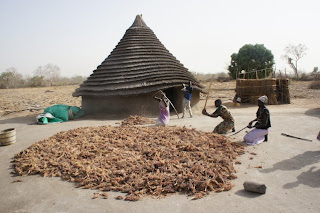Heading to Lietnhom tomorrow to do some work at seed fairs and hopefully learn a bit about agricultural trade in Warrap.
There is considerable uncertainly in Kuajok at the moment, amidst calls for mobilisation and youth protests against the UN statement asking South Sudan to withdraw from Heglig. I can feel the battle lines hardening almost daily.
Kuajok is on the road to Abyei and the nightly movements of SPLA troops and supplies are getting louder, as the soldiers play music and blast the megaphone through the town at 3am (soldiers move at night, I have discovered).
Things are mostly business as usual, but the price of fuel has shot up (more than doubled) over 24 hours and once it starts going up...it tends to have its own momentum. Currently at 35ssp per just over a litre. Price of commodities will follow. Price of dollars on the black market already increasing too.
Probably out of internet and phone reception for the next week or so...
There is considerable uncertainly in Kuajok at the moment, amidst calls for mobilisation and youth protests against the UN statement asking South Sudan to withdraw from Heglig. I can feel the battle lines hardening almost daily.
Kuajok is on the road to Abyei and the nightly movements of SPLA troops and supplies are getting louder, as the soldiers play music and blast the megaphone through the town at 3am (soldiers move at night, I have discovered).
Things are mostly business as usual, but the price of fuel has shot up (more than doubled) over 24 hours and once it starts going up...it tends to have its own momentum. Currently at 35ssp per just over a litre. Price of commodities will follow. Price of dollars on the black market already increasing too.
Probably out of internet and phone reception for the next week or so...















